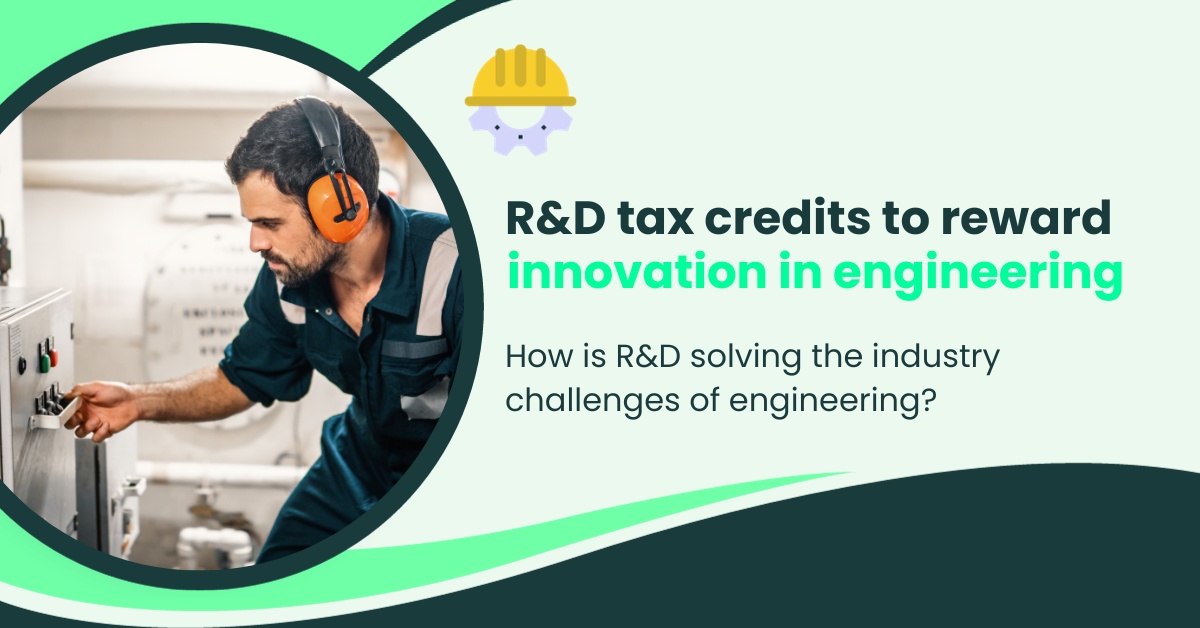R&D tax credits offer an unmissable opportunity to the engineering industry for businesses that are involved in innovation and technological advancement. As the industry grapples with ever-evolving challenges and opportunities, understanding the pivotal role of R&D becomes paramount. The engineering industry, at its core, encompasses the concept of R&D tax credits because engineering uses scientific principles and mathematical expertise to design, innovate, and construct solutions for a variety of challenges. That’s why this industry is responsible for a large proportion of R&D claims year after year. This article will define that role and explore how industry challenges are being solved through eligible R&D activities.
What are R&D tax credits for engineering?
R&D tax credits are government incentives encouraging innovation in engineering by providing financial benefits to companies investing in research. These credits, under the SME scheme and RDEC, aim to stimulate the development of new products, processes, and improvements within the engineering sector. Qualifying activities may include material development, process enhancement, and innovative solutions to technical challenges. Leveraging R&D tax credits helps engineering firms offset expenses, fostering a cycle of innovation and maintaining competitiveness.
To have a strong R&D claim on your hands, you need to meet the eligibility criteria. Essentially, you need to have spent money on your R&D HMRC will reward you financially if your R&D activities have the aim of enhancing the performance, reliability, quality and functionality of a product or software.
What does R&D look like in engineering?
There are many subsectors within engineering that engage with research and development such as robotics engineering, telecommunications, nuclear engineering and more. Examples of R&D in engineering projects include:
Civil engineering
This involves the design and construction of infrastructure such as buildings, bridges, roads, and water supply systems. An example of an R&D project is developing a novel construction material with enhanced durability and sustainability for building structures. Many people believe that to be eligible, you need to create something brand new. This is not the case; you can improve something that already exists. This example shows this, as this project enhances an already existing material.
Mechanical engineering
This subsector focuses on the design and development of mechanical systems and devices, including machines, engines, and HVAC systems. R&D may look at designing a high-efficiency and environmentally friendly engine for electric vehicles to advance automotive technology.
Electrical engineering
As electrical engineering deals with the study and application of electricity, electronics, and electromagnetism, encompassing fields like power systems and telecommunications, R&D could involve developing lightweight and high-strength materials for use in the construction of aircraft wings to improve fuel efficiency.
Computer engineering
Computer engineering combines principles of electrical engineering and computer science, focusing on the design and development of computer systems and networks. An example is: designing a quantum computer prototype to explore the potential of quantum computing for solving complex problems.
Biomedical engineering
Principles of engineering and biological sciences to develop technologies for healthcare are integrated including medical devices and imaging systems. A great R&D claim would be to create an innovative medical imaging device with higher resolution and reduced radiation exposure for improved diagnosis.
What industry challenges are being solved by R&D in engineering?
R&D in engineering plays a crucial role in addressing a wide range of industry challenges, driving innovation and finding solutions to complex problems.
Climate change and sustainability
Developing eco-friendly technologies, renewable energy sources, and sustainable practices to mitigate the environmental impact of industrial processes and infrastructure.
Energy efficiency
Researching and implementing technologies to enhance energy efficiency in various sectors, including manufacturing, transportation, and building systems, to reduce overall energy consumption.
Infrastructure resilience
Designing and improving infrastructure to withstand natural disasters, such as earthquakes, floods, and hurricanes, ensuring long-term resilience and safety.
Healthcare advancements
Innovating medical devices, diagnostic tools, and treatment methods to improve healthcare outcomes, enhance patient care, and address emerging health challenges.
Transportation innovations
Designing and implementing advanced transportation systems, including electric vehicles, autonomous vehicles, and high-speed rail, to improve efficiency, reduce emissions, and enhance safety.
The benefits of R&D tax credits for engineering
R&D tax credits offer the engineering industry a financial incentive to invest in innovation, providing a means to offset a portion of the costs incurred during research and development activities. This encourages engineering firms to pursue groundbreaking projects, fostering technological advancements and maintaining competitiveness. By reducing the financial burden associated with R&D, these credits stimulate ongoing innovation, leading to the development of cutting-edge solutions and the continuous evolution of the engineering sector.
Case study of R&D in engineering
To give one example of the broad scope of R&D eligibility, you can read one of our engineering client’s case studies. Our client undertook a project to re-engineer a high-performance unmanned aircraft integrating advanced data analytics with Artificial Intelligence (AI) and solar panel technology to enhance cost efficiency and optimise flight duration. Through trial and error with solar, fuel cells, and battery energy sources, along with implementing AI for sensor data fusion, they successfully improved UAV capabilities, specifically in obstacle detection, navigation, and overall safety, leading to a successful R&D claim supported by technical and financial evidence.
Concluding thoughts on R&D in engineering
R&D tax credits are a crucial opportunity for the engineering industry, rewarding businesses engaged in innovation. Understanding the industry's reliance on scientific principles and mathematical expertise, coupled with evolving challenges, underscores the significance of R&D. Eligibility for tax credits extends beyond creating entirely new products to improvements on existing technologies. The article showcases diverse R&D applications across engineering subsectors and illustrates how these credits benefit the industry by providing financial incentives for innovation.
How does Alexander Clifford support innovation in engineering?
As specialists in R&D tax relief, our team has worked with a wide range of businesses in the engineering sector to retrieve R&D tax credits for them with a high-quality claim. Our processes keep your R&D claim aligned with HMRC’s standards of compliance, preventing the chance of receiving a time-consuming enquiry. We love learning about the process of an idea, start to finish, which we discuss in our technical calls. Want to know what your R&D claim could be worth? Get in touch.


No comments yet